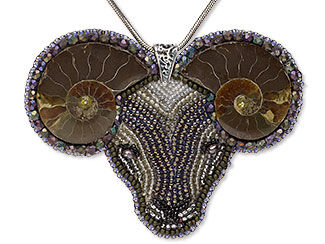Ammonite Meaning and Properties
Ammonite History
One of the most widely known fossils, ammonites are eoliths of now-extinct marine mollusks called ammonoids. Due to the sheer number of ammonoids before they became extinct 65 million years ago, there is quite an abundance of fossils found today. The name ammonite comes from the god Ammon, who had spiral ram horns and was originally an Ethiopian or Libyan deity that later was worshipped all over Egypt and parts of Greece.
What are the Metaphysical Properties of Ammonite?
It's no surprise that ammonites, with their spiral shape, are symbols of change and positive motion. The spiral is said to draw in negative energy, filtering it through the chambers and releasing fresh, positive energy. Due to this connection with energy, ammonites have been used for activating Kundalini—the concept in Dharma that refers to primal energy (called shakti)—which coils at the base of the spine and is a source of life force or energy. Ammonite meaning is associated with ancient knowledge, which makes sense considering how long these fossils have been around.
Though ammonite is not a birthstone, it has come to relate to the zodiac signs of Aquarius and Cancer. Ammonite fossils are believed to help with ailments like blood pressure and degenerative disorders, such as those affecting the ears and lungs.
What Chakra is Ammonite?
Chakras are believed to be energy centers within the body that influence physical, emotional and spiritual well-being. Each chakra is associated with specific functions, such as grounding, creativity or intuition. The root chakra, located at the base of the spine, is linked to stability, security and a sense of belonging. Ammonite meaning, in accord with its spiral fossil form and deep earth connection, is often associated with the root chakra. Wearing an ammonite chakra bracelet is thought to help promote grounding energy, support emotional stability and encourage a strong foundation in both life and self.
Root Chakra (Muladhara) - Red
- Location: base of spine in the coccyx or tailbone area
- Represents: foundation of self; grounding energy; survival instincts; physical needs (including financial stability); food
- Emotional issues: safety
- Spiritual issues: security
- Physical issues: associated with reproductive system; adrenal system; food or satiety
- Gemstones: ammonite, bloodstone, garnet, obsidian, smoky quartz
What is Ammonite Made From?
Ammonite fossils have been found on every continent, in all sorts of sizes and in lots of colors, though the most common naturally occurring colors for these fossils are brown and grey. Ammonite fossils formed when ammonoids died and their shells became embedded in sand or silt. The shell was protected from damage over time, due to the sedimentation. As the layers formed and created pressure on the shell, mineral-rich water would seep into the chambers and eventually crystallize into the rock-like fossil we find today. Ammonite can sometimes end up with a rainbow-like sheen on the surface, opalized or pyritized.
- Mineral Information: Calcium carbonate + impurities
- Chemical Composition: CaCO3
- Color: Brown, grey, rarely other colors
- Hardness: 3-1/2 to 4 (Mohs)
- Specific Gravity: 2.7
- Refractive Index: Not applicable
How Do You Clean Ammonite?
Despite lasting as long as the ammonite had to for fossilization and discovery, ammonites aren't particularly durable, with a Mohs hardness of about 4. Only gentle cleaning methods of lukewarm water and mild soap are recommended. Dry the fossil with a soft cloth not impregnated with other cleaning agents. Store ammonites and ammonite jewelry away from harder materials in its own tray with a velveteen insert or a soft velvet bag. If participating in rigorous physical activity, remove ammonite jewelry beforehand.
Ammonite FAQ
Q: Is all ammonite fossilized in the same way?
A: There are several ways in which ammonite fossils can form:
- In many ammonite fossils, mineral-rich groundwater seeped into the shell’s internal spaces, gradually filling them and preserving a detailed replica of the ammonite’s iconic spiral form. This process, known as permineralization, is responsible for the beautifully preserved specimens commonly found in the jewelry marketplace.
- In some ammonites, the original shell material was gradually replaced by minerals—a process known as replacement fossilization. One of the most prized examples is the opalized ammonite, also called ammolite, in which the shell was replaced by opal. This transformation can produce a stunning iridescent sheen, though not all specimens display this vivid coloration.
- Another form of ammonite fossil is known as a mold-and-cast fossil. Similar to how a dinosaur footprint is preserved, the ammonite left an impression in soft sediment or rock. Over time, that impression was filled with minerals, forming a three-dimensional replica of the original shell.
Q: How old is ammonite?
A: Scientists estimate that ammonites lived as far back as 400 million years, and went extinct around 66 million years ago, coinciding with the mass extinction that wiped out most dinosaurs, flying reptiles like pterosaurs and marine reptiles such as ichthyosaurs and mosasaurs—both of which preyed on ammonites.
Q: What makes ammonite valuable?
A: Ammonite holds intrinsic value due to its rich historical significance, striking beauty and unique characteristics. The monetary worth of an individual ammonite fossil depends on various factors, including its structure, size, distinctive patterns and color—with special emphasis on iridescent specimens—along with clarity, species rarity, fossil provenance and prevailing market trends.
Q: Can ammonite be drilled?
A: Ammonite is a type of stone and can be drilled; however, caution is essential because it may be brittle or contain hidden internal cracks. When drilling ammonite, proceed slowly and carefully to avoid damage.
Q: Are there fake versions of ammonite?
A: Yes, imitation ammonites do exist. To ensure authenticity, always buy from reputable sources. Watch out for unnatural colors or overly perfect shapes and check for the solid, substantial weight typical of genuine fossil ammonites.
Designing with Ammonite
Since ammonite is an ancient fossil, it pairs perfectly with other naturally occurring unique-looking formations such as druzy. Combine ammonite with other earth-toned gemstones with fossils such as fossil coral or fossil agate for a natural, neutral color palette. Try using other fossils such as shark teeth , orthoceras or septarian to really play up the ancient aspect. Ammonites are ideal for use as necklace pendants and drops in earrings rather than bracelets or rings where they are more likely to sustain damage.
A Design Inspiration to Get You Started
Shop for Ammonite
**Please note that all metaphysical or healing properties listed are collected from various sources. This information is offered as a service and not meant to treat medical conditions. Fire Mountain Gems and Beads® does not guarantee the validity of any of these statements.
How did you like this resource? Your feedback helps us provide resources that matter to you most.
Copyright Permissions
All works of authorship (articles, videos, tutorials and other creative works) are from the Fire Mountain Gems and Beads® Collection, and permission to copy is granted for non-commercial educational purposes only. All other reproduction requires written permission. For more information, please email copyrightpermission@firemtn.com.


